Plenty of very easy ways to check what CPU you have on your PC exist. All of these involve following a few simple steps.
To check your processor make and model, you can use built-in system utilities and services such as the About window, Task Manager, or Device Manager. You can also get comprehensive information regarding your CPU and its specs using trusted (free) third-party software such as CPU-Z.
In the following text, I will talk in detail about how to check what CPU you have and also touch base on important CPU specifications and why they should matter to you as a buyer.
TABLE OF CONTENTS
How to Check What CPU You Have?
There are many simple ways to check what CPU you have. If it is already installed on the PC, then the following four methods should help:
1. Checking What CPU You Have Using the ‘About’ or ‘System Settings’ Window
You can find out the make and model of your processor by heading to the ‘About’ window or the System Settings.
The ‘About” window can tell you the make, model, and base clock speed of the CPU installed in the PC as well as its architecture.
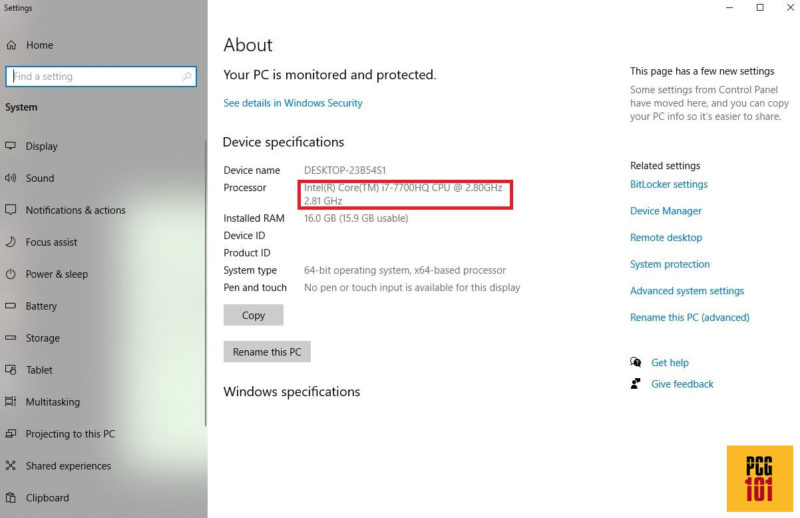
Image: The ‘About” window
Here you can see the following details about my processor:
- Make: Intel
- Model: Core i7-7700HQ
- Base Clock Speed: 2.80 GHz
- Architecture: x64 – you can see the CPU architecture in the “System Type” field.
There are multiple ways to access the About screen:
1. Using the Windows Search Bar
On Windows 10, type “About” in the search bar and click “About Your PC.”
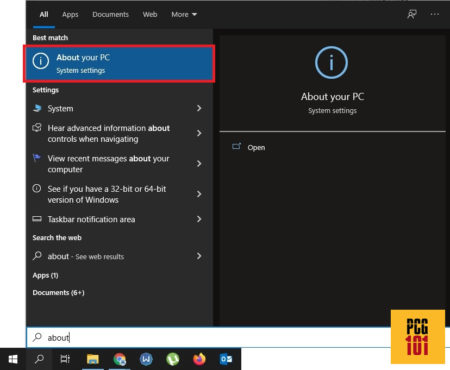
2. By Right Clicking “This PC.”
Another relatively easy way to access this window is to Right Click “This PC” and select “Properties” from the drop-down menu.
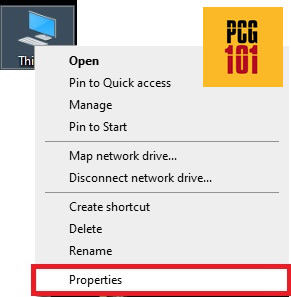
3. By Accessing the Control Panel
The Control Panel is the third way to access the “About” or the “System Properties” Window.
With the “Control” Panel open, click on “System”:
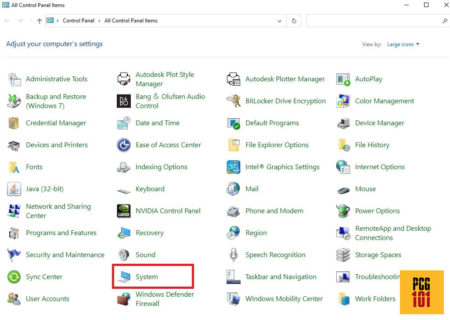
Limitations of this Method
While the “About” window is a great way to figure out the make and model of your PC, it doesn’t provide a whole lot of details and information regarding your processor.
It doesn’t tell you the core count, thread count, boost clock speed, etc. To know more about your CPU, I recommend the following methods.
2. Checking Your CPU Using Task Manager
Another relatively simple way to learn not just about your CPU’s make and model but also its important specs, as well as its current usage, is to head over to the Task Manager:
There are two easy ways to access Task Manager:
- Right-click on the Task Bar
- Select “Task Manager” from the menu.
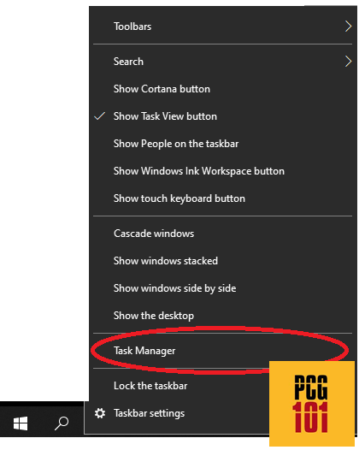
Alternatively,
- Press CTRL+ALT+Del – this should open a new screen
- Select Task Manager from the list
With the Task Manager open,
- Select the “Performance” Tab from the top menu
- Then select “CPU” from the Left-Hand side menu
- The resulting screen shows essential details regarding your CPU
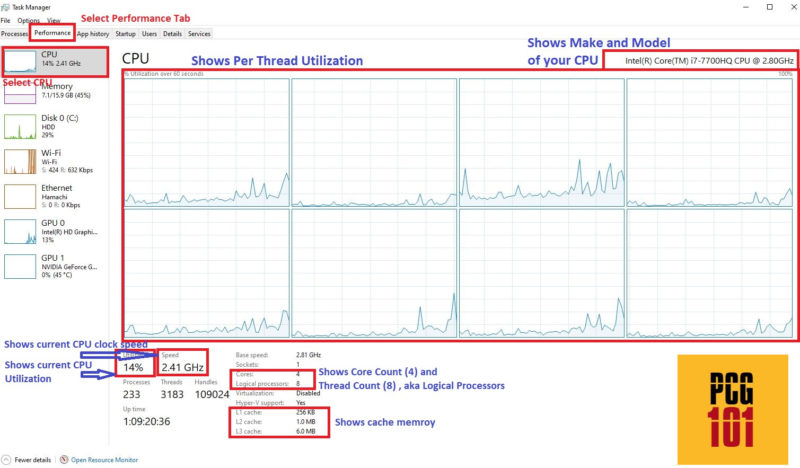
Task Manager is an excellent way to learn about your CPU’s specifications and get insight into its usage.
Here you can see:
- Make: Intel
- Model: Core i7-7700HQ
- Base Clock Speed: 2.80 GHz
- Current CPU Usage: Task Manager also shows you the current overall utilization of the CPU (14% in this case), as well as the utilization per thread
- Current CPU Speed: You can also learn about the current CPU clock speed of the speed (2.41 GHz in this case)
Note that depending on how much the CPU is being utilized or whether it is being run on the battery (in the case of laptops), the current CPU clock speed can get lower or higher than the base clock speed.
For instance, my CPU, the Intel Core i7-7700HQ, has a base clock speed of 2.80 GHz. However, operating on battery (power saving mode) clocks down to around 2.4 GHz to conserve battery.
On the flip side, if you are performing strenuous tasks, it can even go beyond the base 2.80 GHz clock speed. My CPU can go to a max clock speed of 3.80 GHz (called Boost Clock Speed), which varies from model to model.
Limitations of This Method
Task Manager is one of the most comprehensive built-in utilities to get information regarding your processor.
However, if even this is lacking or if you want to find out information regarding the iGPU the CPU offers, its TDP, PCIe Lane count, total RAM supported, etc., then heading over to the spec sheet would be the best idea.
3. Checking Using Device Manager
Another simple method to check what CPU you have is to access the Device Manager utility.
To access Device Manager:
- Type “Device Manager” in the Windows search field
- Select Device Manager from the search results
- This should open up a new Window detailing all the components currently installed on your system.
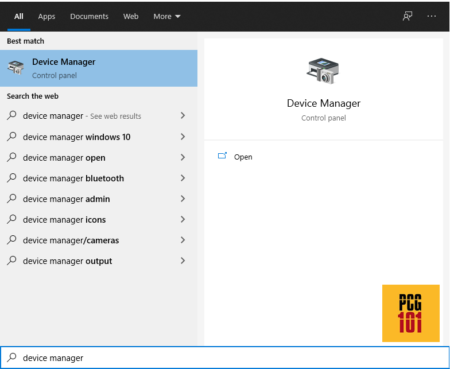
Once in Device Manager, expand the “Processors” section. Here you will be able to learn about your CPU’s make, model, and base clock speed.
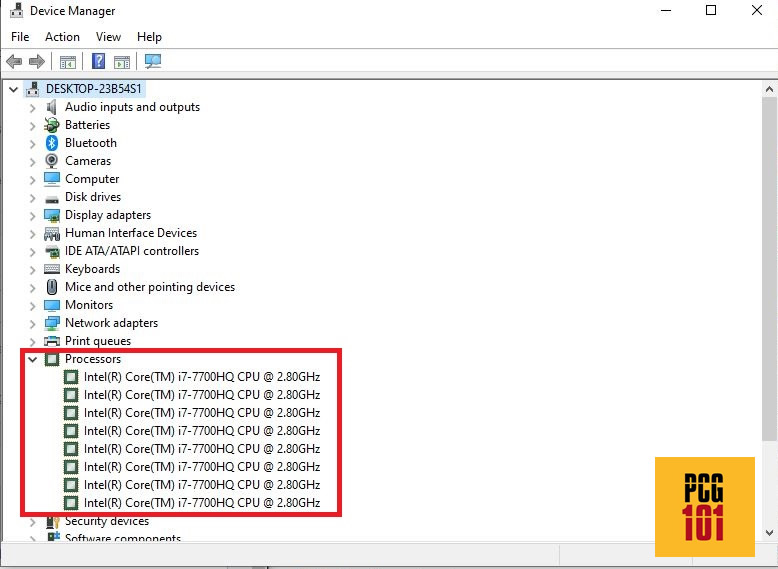
Note that the number of times this list shows the CPU name corresponds to how many threads it has.
For instance, in my case, the Device Manager shows the processor name eight times – the number of threads this processor has on paper.
One of the plus points about accessing Device Manager is that it shows the entire list of all the components you have currently installed on your PC.
In addition, it tells you their driver information and indicates whether a certain device/component is failing due to driver issues.
Limitations of this Method for Checking Out the CPU
Again, this method shows only the basic details about your CPU, i.e., its make, model, and base clock speed.
4. Checking Using Third-Party Software – CPU-Z
The final method I recommend for checking out what CPU you have is to use the popular free third-party software called CPU-Z.
This is a very light utility that can be downloaded and installed free of cost.
Running this utility will give you information regarding your CPU and the rest of the primary components, i.e., RAM, motherboard, and graphics card.
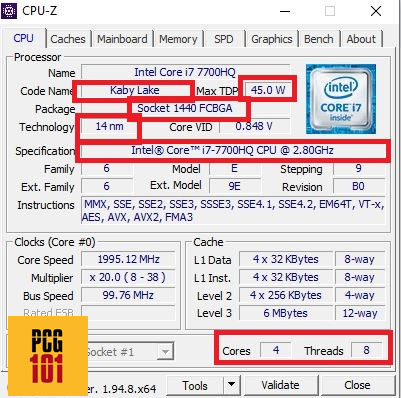
Here you can see a plethora of information:
- Make and Model: Intel Core i7-7700HQ
- Base Clock Speed: 2.80 GHz
- Socket: FCBGA 1440
- Transistor Size: 14nm
- Generation It Belongs to: Kaby Lake
- Core Count: 4
- Thread Count: 8
- Max TDP: 45W
If you head over to the ‘Graphics’ Tab, it also shows its integrated graphics, i.e., Intel HD 630.
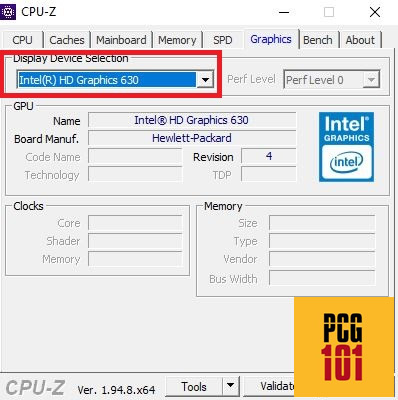
Image: CPU-Z. Make sure you have selected the right GPU from the drop-down menu.
Also Read: How to Check What Motherboard You Have?
Also Read: How Many Pins Does a CPU Have?
Check Out What CPU You Have If It’s NOT Installed
If your CPU is not currently installed, the only definitive way to check what CPU you have is to read the label on it physically.
The make and model of the CPU is almost always inscribed on the CPU surface.
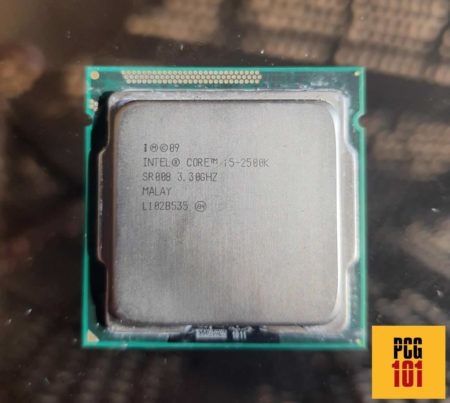
Image: Intel Core i5-2580K
Also Read: Where is the CPU Located in a Computer?
Understanding the CPU Specs
To truly understand your CPU and its capabilities, you need to understand the important CPU specs.
Basic CPU Models and the Performance Hierarchy
For starters, there are primarily two CPU manufacturers for the PC market: AMD and Intel.
AMD and Intel have several lines of CPUs differentiated often by their performance.
The following list describes the CPU performance Hierarchy
- Intel Celeron: Most budget-level CPUs (Very weak performance)
- Intel Pentium/AMD Athlon: Entry-Level CPU (Weak Performance)
- Intel Core i3/AMD Ryzen 3: Budget Mainstream CPU (Great for average power users).
- Intel Core i5/AMD Ryzen 5: Mainstream CPU (Popular among gamers and professionals)
- Intel Core i7/AMD Ryzen 7: High-Performance CPU (For professional gamers, game streamers, editors, and designers).
- Intel Core i9/AMD Ryzen 9: Workstation grade CPU (for elite users).
Knowing which line your CPU belongs to can tell you much about where it stands in terms of performance.
Also Read: What is AMD Equivalent to Core i5?
CPU Generation and Socket Information
The performance of a CPU can improve drastically with each newer generation.
You can tell what generation your CPU belongs to by reading the first or the first two digits of the model name.
For Intel
- If the CPU model has four numerical digits, i.e., Intel Core i5 9400, the first digit corresponds to the generation, i.e., “9”400 – 9th generation.
- If the CPU model has five numerical digits, i.e., Intel Core i5 11400, then the first two digits correspond to the generation, i.e., “11”400 – 11th generation.
For AMD
- The first numerical digit of the model name corresponds to the generation it belongs to, i.e., AMD Ryzen 5 3600X belongs to the 3rd generation.
Each new generation can significantly differ in performance, core count, thread count, and clock speed.
In addition, newer generations often introduce smaller transistors making the CPU more efficient.
For instance, the second generation of AMD Ryzen processors had a 12nm transistor size. With the third generation, AMD reduced the size to 7nm making their CPUs more efficient.
Additionally, each newer generation may introduce a newer socket.
For instance, 9th gen Intel CPUs use the LGA 1151 socket, 10th and 11th Gen use the LGA 1200 socket, whereas the 12th gen uses the LGA 1700 socket.
You have to make sure you have the right motherboard with the right socket to plug the CPU in.
You can find out what socket your CPU has through its spec sheet:
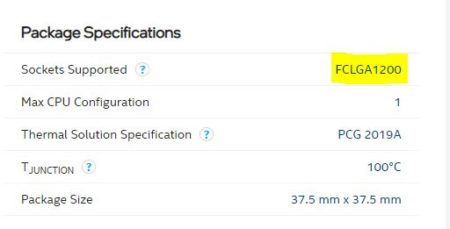
Intel Core i7-11700K CPU socket. Source: Intel
Also Read:
TDP – Whether It is a Low Powered or a High-Performance CPU
Processors are also differentiated in terms of how much energy they consume. This is roughly defined by the TDP (Thermal Design Power) and is expressed in Watts.
Desktop CPUs have a high TDP since power delivery and heat dissipation are not as big of an issue as on a laptop.
With laptops, however, CPU can vary tremendously in terms of how much power they consume.
Take, for instance, the following:
| CPU | TDP | Platform | Core/ Thread | Clock Speed | Passmark Score |
|---|---|---|---|---|---|
| Intel Core i7 11700K | 125 | Desktop | 8/16 | 3.6 - 5.0 GHz | 25127 |
| Intel Core i7 11700 | 65 | Desktop | 8/16 | 2.5 - 4.4 GHz | 21119 |
| Intel Core i7 11800H | 45 | Laptop | 8/16 | 2.3 - 4.6 GHz | 21625 |
| Intel Core i7 1165G7 | 28 | Laptop | 4/8 | 2.80 - 4.7 GHz | 10650 |
| Intel Core i7 10510U | 15 | Laptop | 4/8 | 1.80- 4.90 GHz | 6882 |
Here you can see that for desktops, normal CPUs nominally consume about 65 Watts of power. However, unlocked (overclockable) CPUs can consume more, i.e., 125 watts (more below).
But the important point to note is that laptops often have two kinds of CPUs in the market and within each CPU series.
First are the high-performance CPUs such as the Intel Core i7 11800H, and the second are ultra-low-powered CPUs such as the Intel Core i7 1165G7 and Intel Core i7 10510U.
High-performance laptop CPUs often have the ‘H‘ suffix in their name, whereas low-powered CPUs have the ‘U‘ or, more recently, the ‘G‘ suffix.
The high-performance laptops’ CPUs have a higher core count, clock speed, and much better performance. However, they result in a much shorter battery life. They are excellent for professionals and gamers.
On the other hand, low-powered CPUs have a lower core count and clock speed, but they offer a much longer battery life. These CPUs are excellent for mobility.
Also Read: How to Monitor CPU and GPU Temp While Gaming?
Whether the CPU is Overclockable or Not
PC Gamers and professionals often like to overclock their CPUs to take the clock speed beyond the stock speeds.
This is done through overclocking.
With AMD, things are simpler; all their CPUs support overclocking.
Only the ‘K’ series or ‘Unlocked’ processors can be overclocked with Intel.
Also Read: How To Check if CPU is Overclocked?
CPU Cores and Threads
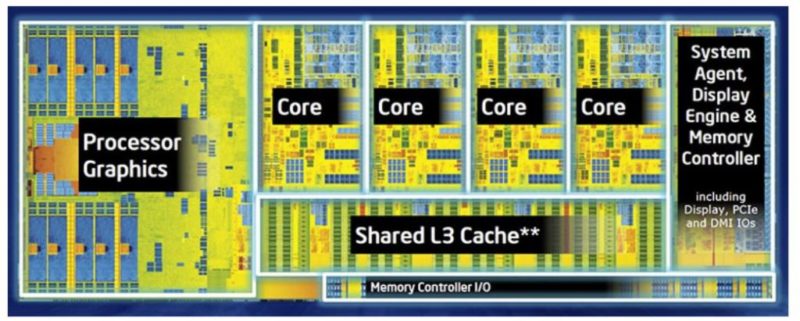
Image: Intel Core i7-4770K chart showing four separate cores and the integrated graphics card on CPU dye.
Cores are a crucial element of a CPU. The core is a physical hardware unit located within the CPU Dye.
A Core is essentially a mini CPU within the more prominent CPU dye. A Core has its registers, cache memory, and ALU, and each core can perform the Fetch-Decode-Execute cycle independently.
Threads, on the other hand, are a virtual or software-based element of the CPU. The tasks that you perform on your PC are assigned to a Thread.
Therefore, the more threads you have, the more tasks your PC can run simultaneously and seamlessly.
Essentially, every core corresponds to a single thread. However, if the CPU enabled multi-threading, each core would have two threads. Hence you will often see a CPU with four cores/eight threads or eight cores/16 threads.
Also Read:
Does More Core = Greater Performance?
Not necessarily. Many aspects define how the CPU will perform your intended tasks.
For instance, gaming on an Intel Core i7 with eight cores and 16 threads would be overkill, as most games do not come close to utilizing all eight cores.
However, if you are a gamer AND a streamer, the more cores you have, the better your gaming + live streaming experience will be. This is because encoding video is a very CPU-heavy task:
Encoding can be taxing on your system. x264 will utilize a lot of your CPU, resulting in lower FPS. – Twitch.tv
Additionally, while graphic designing and web development may not benefit from a stupendously high core count, video rendering, on the hand, is a signature task that requires as many cores as you can throw at it.
Therefore, the question does more core = greater performance is not necessarily true. The performance gain you may experience from a CPU with a higher core count depends on your tasks.
If your CPU cores are not being utilized by the tasks you perform in the first place, you won’t necessarily experience much of a performance difference.
Single-Core vs. Multiple-Core Performance Difference
All CPUs are measured by their Single Core and their Multi-Core performance scores.
The Single Core performance of a CPU is equally as important as its multi-core performance. This is because most of the tasks performed in software and most of the codes run by a game are Single-Core based.
Multi-core performance measures the performance of the CPU with all of the cores working at total capacity. Single Core performance a CPU is measured with only a Single Core working at a time.
CPUs within the same generation often have a similar single-core performance.
For instance, the following comparison of AMD Ryzen 5 5600X vs AMD Ryzen 7 5800X. The former has six cores / 12 threads, while the latter has eight cores / 16 threads. They, however, belong to the same generation, i.e., the 5000 series, and they also have a similar clock speed.
Cinebench R23 Single Core (AMD Ryzen 5 5600X vs AMD Ryzen 7 5800X)

Image: AMD Ryzen 5 5600x vs. Ryzen 7 5800x Single Core Performance Benchmark. Source: CPU-Monkey
The single-core performance of the two is almost similar.
Cinebench R23 Multi Core (AMD Ryzen 5 5600X vs AMD Ryzen 7 5800X)

Image: AMD Ryzen 5 5600x vs. Ryzen 7 5800 Multi-Core Performance Benchmark. Source: CPU-Monkey
Naturally, due to the higher number of cores, AMD RYzen 7 5800X takes the cake here. Again, you will only see this benefit if your work utilizes all eight cores.
Also Read: How to Check How Many CPU Threads You Have?
CPU Clock Speed
Clock speed is another measure of the CPU performance. People often confuse Clock speed as the primary characteristic defining the CPU’s performance.
That is hardly the case.
While a higher Clock speed does improve the performance, many other factors define a CPU’s performance, including the number of cores it has, its transistor size, etc.
For instance, the Intel Core i7 1165G7 with a base and boost clock speeds of 2.80-4.7 GHz and the Intel Core i7 11800H with a base and boost clock speed of 2.3-4.6 GHz.
Despite having a higher clock speed, the Core i7 1165G7 is much weaker than the Intel Core i7 11800H (Passmark scores of 10650 vs. 21625, respectively).
Also Read: What is a Good Processor Speed for Laptop?
CPU’s Integrated Graphics Card
Many CPUs offer integrated graphics.
An Integrated graphics card (iGPU) is a bare minimum for video processing and displaying visuals on your monitor screen.
In terms of performance, they are far from being comparable to mid to high-end dedicated graphics cards. However, depending on what iGPU your CPU has, you may be able to play AAA titles on lower settings.
AMD RX Vega 7 and AMD RX Vega 8 iGPU, as found in the 4000 and 5000 series Ryzen CPUs are some of the most powerful iGPUs out there that can be used as replacements for entry-level dedicated graphics cards.
AMD ‘G’ Series CPUs have iGPU
It is worth noting that not all AMD CPUs have an iGPU.
With AMD, only the ‘G’ series CPUs, such as the AMD Ryzen 3 3200G, and AMD Ryzen 7 5700G, featured an integrated graphics card.
Intel ‘F’ Series CPUs LACK an iGPU
With Intel, the opposite is the case. All except the ‘F’ series CPUs feature an iGPU. For instance, Intel Core i5 10400F, Intel Core i5-11600KF, etc., lack an iGPU.
NOTE: Motherboard Back I/O Need an iGPU

Image: The back I/O ports on any motherboard are powered by the iGPU as the motherboard itself does not have any graphics processing chip. Image: Asrock AMD A320M-HDV R4.0
A very important consideration is that motherboards do not have an onboard graphics processing chip.
Therefore, the video output ports found on the back I/O panel of the motherboard rely on the CPU’s integrated graphics card to run.
In other words, if your CPU lacks an iGPU, the video output ports on the motherboard will NOT work.
You can find out what iGPU your CPU has through the spec sheet. The spec sheet will also highlight how many displays the iGPU can support – which is essential for building a multi-monitor setup.
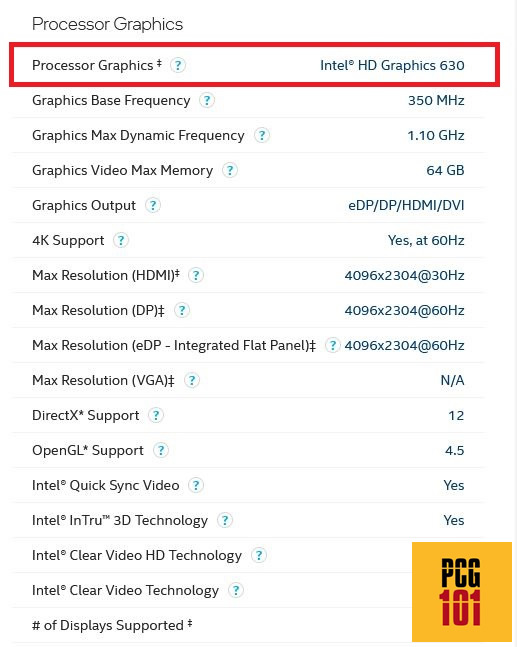
Also Read:
PCIe Lanes and PCIe Version of Your CPU
The expansion cards you install on the PCIe slots on the motherboard connect to PCIe lanes.
PCIe lanes are information highways that transmit data from the connected expansion cards to the CPU.
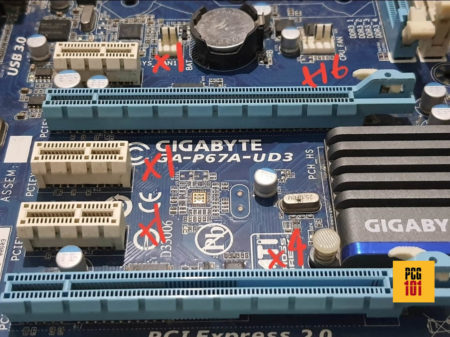
Image: PCIe Slots for adding expansion cards. Note that the bottom x16 slot actually only has four lanes. You can figure this out by reading the spec sheet of the motherboard.
The number of PCIe lanes an expansion card uses depends on how much data it generates. A wireless network card doesn’t generate much data and requires one lane, aka x1. An SSD requires four lanes, aka x4. A graphics card, the most demanding expansion card, requires 16 lanes, aka x16.
Now the amount of PCIe lanes you have on your system is limited, and the CPU governs them, make and model, and the motherboard chipset.
The more PCIe lanes you have, the more expansion cards you can connect.
Here is how many PCIe lanes Intel and AMD CPUs provide:
- Intel 10th Gen and older CPUs: 16 PCIe lanes
- Intel 11th Gen and newer: 20 PCIe lanes
- AMD Ryzen Series CPUs (Desktop): 24 PCIe lanes (only 20 users accessible)
In addition to that, the version of the PCIe protocol also matters. Every newer generation of PCIe doubles the per-lane transfer speed.
The following tables show different PCIe versions’ throughput rates (speed) for different lane counts.
| Version | x1 (GB/s) | x2 (GB/s) | x4 (GB/s) | x8 (GB/s) | x16 (GB/s) |
|---|---|---|---|---|---|
| 1.0 | 0.250 | 0.500 | 1.000 | 2.000 | 4.000 |
| 2.0 | 0.500 | 1.000 | 2.000 | 4.000 | 8.000 |
| 3.0 | 0.985 | 1.969 | 3.938 | 7.877 | 15.754 |
| 4.0 | 1.969 | 3.938 | 7.877 | 15.754 | 31.508 |
| 5.0 | 3.938 | 7.877 | 15.754 | 31.508 | 63.015 |
| 6.0 | 7.877 | 15.754 | 31.508 | 63.015 | 126.031 |
The PCIe version of your system also depends upon the CPU and Motherboard chipset you have.
I recommend reading the following articles to learn more about PCIe lanes:
Cache Memory
Cache memory isn’t a super important specification for you to consider as a buyer, but of course, the higher your CPU’s cache memory, the better its performance.
Cache memory is basically the fastest RAM found on your PC. It is similar to your usual RAM sticks in its basic function, but instead, it is super fast. The cache memory holds the most common instructions that a CPU uses regularly.
It is also integrated within the CPU itself. This close proximity of the cache memory to the rest of the CPU sub-components makes accessing repetitive instructions very fast.
There are three levels of the Cache memory, namely L1, L2, and L3 – L1 being the smallest but also closest to the CPU core. This is the fastest cache level. L3 is the largest but also the slowest of the cache memory.
It is always good to have a CPU with the most cache memory. However, this spec should not be the primary deal maker or deal breaker.
Final Words
Learning how to check what CPU you have, its make, and model is just one half of the story. The other half is actually to figure out how good of a processor you have.
Fortunately, there are many simple ways to determine your CPU. However, to truly understand how it fares compared to the rest of the CPUs in the market, whether it is sufficient for the work you perform, or whether it is time for an upgrade, you will need to conduct some research.
Learning what the CPU specs mean and then learning how to benchmark your CPU by comparing it with the rest of the processors in the market should give you a good grasp of your CPU’s capability.
Also Read: How to Check Form Factor of Motherboard?
Frequently Asked Questions
1. What other information besides the CPU model and clock speed can be obtained by checking the CPU specs?
Checking the CPU specs can provide a wealth of information about your processor, including the number of cores and threads, cache size, and supported instruction sets. It can also reveal the CPU’s maximum supported memory, power consumption, and more.
2. How do you know if your CPU is compatible with a specific motherboard?
The compatibility of a CPU and motherboard depends on a number of factors, including socket type, chipset compatibility, and BIOS support. To determine if a CPU is compatible with a specific motherboard, it is important to check the motherboard’s documentation or website for information on compatible CPUs.
3. Can you check the number of cores and threads your CPU has?
Yes, it is possible to check the number of cores and threads a CPU has by checking the CPU specs. This information is important when selecting hardware and software that can take advantage of multiple cores and threads for improved performance.
4. How can you determine the maximum supported memory for your CPU?
The maximum supported memory for a CPU can be determined by checking the CPU specs or by consulting the motherboard documentation.
The maximum memory capacity is usually determined by the CPU’s memory controller and the number of memory channels supported.
It is important to note that the maximum supported memory may also be limited by the motherboard’s chipset and BIOS.
